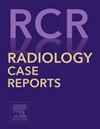Early onset development of hypertrophic cardiomyopathy in less than 1 year in a patient with familial Friedrich's ataxia: Case report
Q4 Medicine
引用次数: 0
Abstract
Friedreich's ataxia (FRDA) is a neurodegenerative disease characterized by progressive ataxia, dysarthria, sensory loss. While neurological symptoms are prominent, cardiac manifestations significantly contribute to mortality. Cardiomyopathy in Friedreich's disease results from mitochondrial dysfunction, loss of contractile proteins and an accumulation of fibrosis in heart. To better characterize the severity of cardiac involvement, the MICONOS study group developed a classification system categorizing FRDA cardiomyopathy as “no,” “mild,” “intermediate,” “severe.”
We report an uncommon case of early-onset development of hypertrophic cardiomyopathy (HCM) in a 25-year-old female diagnosed with Friedreich's ataxia (FRDA) at age 12. Through annual cardiac evaluations, no signs of cardiac disease were noted. Until presenting with dyspnea and palpitations. Clinical examination revealed truncal ataxia and dysarthria, but no signs of heart failure. However, a transthoracic echocardiography demonstrated nonobstructive hypertrophic cardiomyopathy with a maximal wall thickness of 20 mm, incomplete anterior systolic motion of the mitral valve, a significant development in less than 1 year after last normal cardiac assessment. Left ventricular systolic function was preserved (ejection fraction 50%). She was prescribed bisoprolol and dapagliflozin, with significant improvement at her latest checkup. Family screening revealed HCM in her 30 year female sibling, who also has FRDA. No cardiac abnormalities were detected in her younger brother or parents.
Friedreich's hypertrophic cardiomyopathy has been reported as the most significant cause of mortality, especially among younger patients with early onset disease manifestations.
家族性Friedrich共济失调患者早发性肥厚性心肌病在不到1年的发展:病例报告
弗里德赖希共济失调(FRDA)是一种以进行性共济失调、构音障碍、感觉丧失为特征的神经退行性疾病。虽然神经系统症状很突出,但心脏表现显著导致死亡率。弗里德里希氏病的心肌病是由线粒体功能障碍、收缩蛋白的丧失和心脏纤维化的积累引起的。为了更好地描述心脏受累的严重程度,MICONOS研究组开发了一种分类系统,将FRDA心肌病分为“无”、“轻度”、“中度”、“严重”。我们报告了一例罕见的早发性肥厚性心肌病(HCM)的病例,该病例发生于一名25岁的女性,12岁时被诊断为弗里德赖希共济失调(FRDA)。通过年度心脏检查,没有发现心脏疾病的迹象。直到出现呼吸困难和心悸。临床检查显示躯干共济失调和构音障碍,但无心衰迹象。然而,经胸超声心动图显示非阻塞性肥厚性心肌病,最大壁厚为20mm,二尖瓣前收缩运动不完全,在最后一次心脏正常评估后不到1年的时间里出现了明显的发展。左心室收缩功能保留(射血分数50%)。她被开了比索洛尔和达格列净,在她最近的检查中有明显的改善。家庭筛查显示她30岁的女性兄弟姐妹患有HCM,她也患有FRDA。她的弟弟和父母均未发现心脏异常。据报道,弗里德赖希肥厚性心肌病是最重要的死亡原因,特别是在有早发性疾病表现的年轻患者中。
本文章由计算机程序翻译,如有差异,请以英文原文为准。
求助全文
约1分钟内获得全文
求助全文
来源期刊

Radiology Case Reports
Medicine-Radiology, Nuclear Medicine and Imaging
CiteScore
1.10
自引率
0.00%
发文量
1074
审稿时长
30 days
期刊介绍:
The content of this journal is exclusively case reports that feature diagnostic imaging. Categories in which case reports can be placed include the musculoskeletal system, spine, central nervous system, head and neck, cardiovascular, chest, gastrointestinal, genitourinary, multisystem, pediatric, emergency, women''s imaging, oncologic, normal variants, medical devices, foreign bodies, interventional radiology, nuclear medicine, molecular imaging, ultrasonography, imaging artifacts, forensic, anthropological, and medical-legal. Articles must be well-documented and include a review of the appropriate literature.
 求助内容:
求助内容: 应助结果提醒方式:
应助结果提醒方式:


